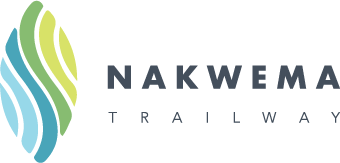The Nakwema Trailway has the ambitious goal of connecting two regional trail networks that link the communities of Traverse City, Acme, Elk Rapids, Eastport, Norwood and Charlevoix with nearly 300 miles of existing non-motorized transportation and recreation trails from Alpena to Suttons Bay.
The Trail will connect the three counties of Charlevoix, Antrim, and Grand Traverse; the seven townships of Acme, Elk Rapids, Milton, Torch Lake, Banks, Norwood, and Charlevoix; the Village of Elk Rapids; and property owned by the Grand Traverse Band of Ottawa and Chippewa Indians.
The trail will pass through beautiful scenery and provide access to numerous public amenities including parks, beaches, natural areas, communities, and other destinations along the US-31 corridor. The project builds on the vision of more than a decade of community groups working to make trail connections.
Wherever you get on. There is no beginning and end, or preferred direction of travel.
The Nakwema Trailway aims to link TART Trails’ trail system between Suttons Bay and Acme Township with the Lake to Lake Trail and Little Traverse Wheelway Trail starting in Charlevoix. The priority for trail development will between Bunker Hill Rd (Acme Township), where the TART Trail currently terminates, and Bells Bay Rd (Charlevoix Township) at the Lake to Lake Trail.
There are many benefits of trails that impact the community, whether you are an active trail user or not. Studies have shown that trails make our communities more livable, improve the economy through tourism and civic improvement, preserve and restore open space, and provide opportunities for physical activity to improve fitness and mental health.

Multi-jurisdictional cooperation will be necessary to construct, manage, and maintain the trail. Partner roles and responsibilities may include property acquisition and ownership, development of trail and associated amenities and facilities (trailheads, signage and restrooms), management authority, maintenance, fundraising, policing and law enforcement, volunteer recruitment and management, promotion, programming, and events.
Construction will require a comprehensive strategy utilizing state and federal grants, contributions from the local units of government, and private funding. Current funding modals project a 60/40 split between public and private funding sources, which includes a long-term maintenance endowment to ensure a premier trail experience for generations.
The Nakwema Trailway will connect to and be a part of Michigan’s non-motorized trail system, which allows visitors and residents to hike, bike, ski, run, walk, and explore the great outdoors, along with our cities and villages. The public will be invited to take advantage of the pathway and enjoy the recreation and transportation opportunities it will provide for locals and tourists alike.
A high priority in the Nakwema planning process is to minimize the number of road crossings to the extent possible. Michigan Department of Transportation design and engineering standards will be maintained along with experienced MDOT trail engineers/designers input throughout the development process.
It has become common for trail groups in Michigan to request access to privately held lands for trail development. Landowners often have questions concerning their risks, liability, and responsibility. The Michigan legislature addresses this issue through the “Recreational Use Statute” to encourage land owners and managers to allow public access for recreation on their lands. The statute offers landowners a very good assurance of protection with the exception of instances of gross negligence. Click here to view an online version.
Agriculture along the trail represents historic and present-day business and cultural practices that are major economic drivers in the region. The path will be designed, with recommendations and input from the agricultural community, in a way that respects and celebrates the importance of agriculture’s role in the region.


